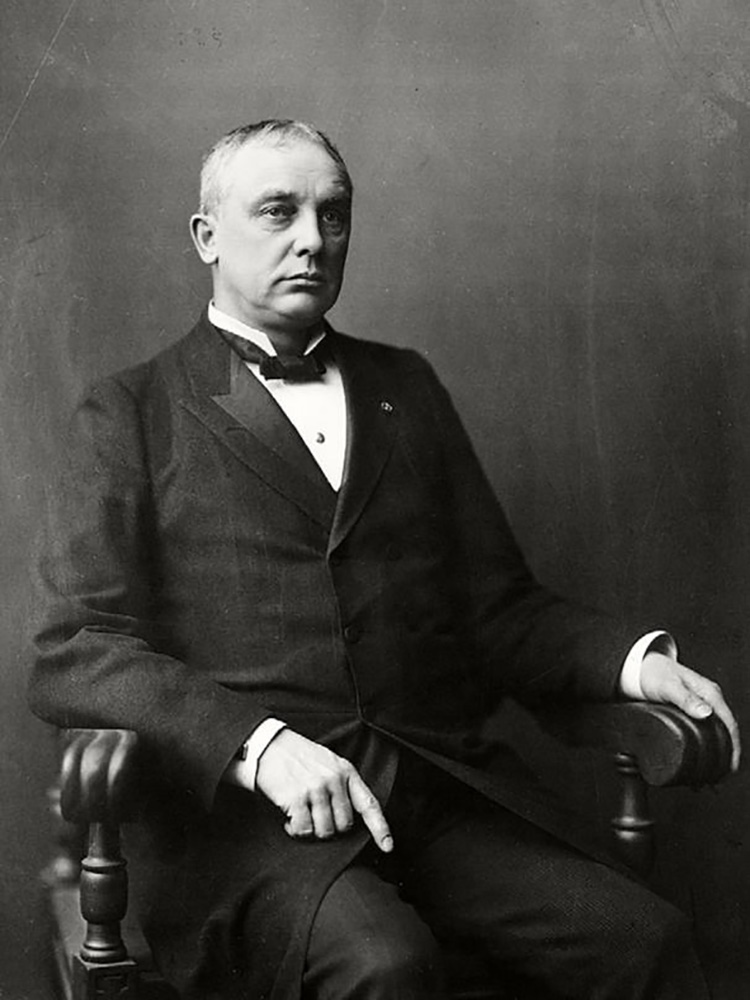Elisha Benjamin Andrews

Chancellorship Dates
September 22, 1900 - November 6, 1908
Degrees
- Brown University, 1871
- Newton Theological Institution, 1874
Born
January 10, 1844 - Hinsdale, New HampshireDied
October 30, 1917 - Interlachen, FloridaInterment
Denison University Cemetery, Granville, OhioArtifacts
Sources
- Origin of the Cornhusker Nickname
- "Prairie University," Robert E. Knoll
- Brunoniana (Brown University Encyclopedia): E Benjamin Andrews
Elisha Benjamin Andrews came to Nebraska after a national search for George MacLean’s successor, during which Charles Bessey served again as interim chancellor. Andrews, who was then serving as the superintendent of schools for the city of Chicago, had administered distinguished institutions before. He led Denison University in Ohio from 1875 to 1879, and his alma mater Brown University as its president from 1889 to 1898.
While the university had plateaued somewhat during MacLean’s tenure after its ascendance under James Canfield, it was still a formidable institution of national stature, and it grew under Andrews' leadership. In 1900, the year that he assumed the chancellorship, Nebraska’s enrollment stood at 2,200 students – a fairly large university for the time. Under his watch, the university grew to nearly 4,000 students.
An examination of the artifacts left by the student body in Canfield’s time, and again but perhaps to a lesser extent in Andrews’, reveals a remarkably talented, inquisitive and accomplished community of scholars driven to compete on the field and in the classroom with other great universities. They were determined to make the University of Nebraska equal to some of the widely revered institutions of the time, and in this Golden Age, largely accomplished the feat. It was during Andrews' time that the university's athletic teams, known variously as the fearsome "Bugeaters" and "Rattlesnake Boys," and the more staid and traditional "Old Gold Knights" in prior years, adopted a name suggested by a local sportswriter, Charlie "Cy" Sherman – the Cornhuskers.
Academically, a culture of debate rose at the university, in which the highest undergraduate academic calling was to be a member of the team led by Miller M. Fogg. The Innocents Society was organized in 1903, in part as a counter to Theta Nu Epsilon, an antiauthoritarian "drinking fraternity." All-male, it was joined by the women's Black Masque a few years later. Both were dedicated to advancing both the individual and the institution, and membership was highly sought after.
Andrews sought and obtained funding from John D. Rockefeller for the university's first student activities building, matched at a 2:1 ratio with state funds after Andrews defeated the famously loquacious William Jennings Bryan in the court of public opinion. Bryan had objected to accepting the charity of a robber baron, but the Temple Building was erected anyway. All told, during his years at the helm, nine new buildings were constructed under Andrews' leadership.
Andrews re-ignited the restless ferment that had previously reached its zenith under Canfield. The university grew considerably during his tenure, and by the end of his chancellorship, the University of Nebraska was the nation's fifth-largest public institution.
According to the historian Robert Knoll in his "Prairie University," "Some persons think him the greatest chancellor the University of Nebraska has ever had and one of the noblest men who have passed this way." Never in the best of health, Andrews spent the remainder of his life in Interlachen, Florida, where he died in 1917. His body was sent back to Denison University in Ohio, where he rests in the campus cemetery. At his funeral, Alexander Meiklejohn, the philosopher, free-speech crusader and university leader, eulogized him:
“Dear, gallant, stalwart, splendid Bennie Andrews. The zest of life was in him to the brim. He loved the things a man might be. Oh, what a gallant fight he made, and what a hard one! I cannot mourn that he is gone; I am too glad that he has been and is. He was a man. Yes, take him all in all, we shall not see his like again.”